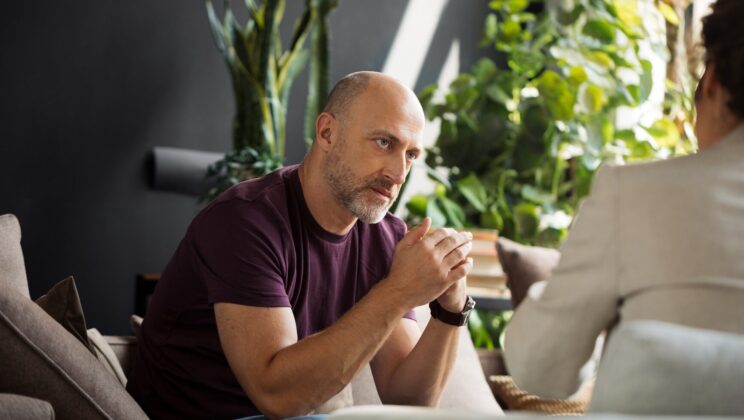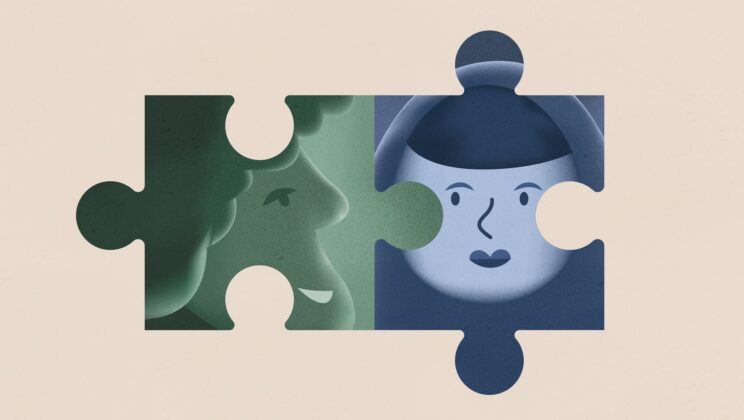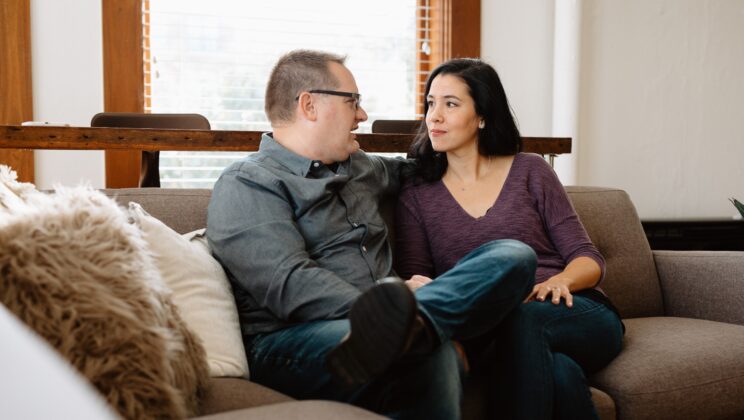Learning to Fly: Breaking Free From Avoidance with Values-Based Exposure
September 7, 2018
Ten years ago I developed a fear of flying, and when I think back, it was like being in a sitcom. I’m walking down the jetway, feeling a little light-headed, my heart already racing. As I board, I notice that one of the plane doors looks a little rusty. I think, this must be an older plane. I peek into the cockpit. There’s no way that pilot can be over 30, how much experience could he possibly have? And he seems tired. I weigh the option of getting off until the doors close and I no longer have a choice.
For the next two hours I sit in my seat completely tense and feeling sick to my stomach. I read every bump and unusual sound as a sign of an impending crash until we miraculously land and I can finally breathe.
I repeated this on my trip home and on every plane trip I took over the next six months. So, the next time I went to visit my parents, 600 miles away, I decided to drive. I told them, “The eight-hour car ride really gives me time to reflect.”
It was such sweet relief to avoid flying – the uncomfortable feelings of anxiety, the thoughts and images of dying. But I felt ridiculous going to such great lengths and looked for evidence that the decision was somehow practical and normal. I found stories on the internet of other people who avoided flying, even celebrities. If exclusively traveling by car or train was good enough for Whoopi Goldberg, it was good enough for me.
On the other hand, I thought about all the places I wanted to visit, and the people I wanted to see. Was I just not going to fly again? It was clear that I wanted and needed to be able to get on a plane, but how to get over my anxiety?
The different ways we avoid
Michael Tompkins, an expert in cognitive behavioral therapy (CBT) for anxiety, defines avoidance and avoidance behaviors as “things you do or don’t do to reduce your anxiety.” Tompkins differentiates between situational avoidance, somatic avoidance, and cognitive avoidance.
Situational avoidance is avoiding a situation or place that may cause discomfort. For example, avoiding planes or elevators if you have a fear of confined spaces. It could also be more general, like avoiding social events when you feel uncomfortable making small talk.
Somatic avoidance is when you avoid things that trigger uncomfortable sensations in your body. For example, if you’ve ever had a panic attack, you may have experienced shortness of breath or a racing heart. As a result, you avoid exercise that could induce these same sensations. I was also engaging in somatic avoidance by not flying – the tension, dizziness, and stomach ache caused by my fear were symptoms I was aiming to avoid.
When you avoid thinking about things that might make you feel anxious or uncomfortable, it’s called cognitive avoidance. In the days leading up to a flight, I would avoid anything that might trigger thoughts about it, like watching a movie that involved flying, talking about my trip, or remembering a previous flight that was particularly bad.
Avoidance, at first, can feel like a nice warm coat. If I didn’t get on a plane, or watch movies about planes, or plan travel with friends, I felt just fine. I had succeeded in avoiding my anxiety. For a short time.
The adverse consequences of avoidance
It didn’t take me long to notice the negative consequences of avoiding plane travel. I felt sad, frustrated, and ashamed that I no longer could do something that I had previously loved and enjoyed. I felt powerless that I couldn’t control what was happening, and I felt embarrassed that I couldn’t be the fun travel buddy I had always been to my friends.
There also could have been relationship consequences if I’d continued down this path. I imagined my friends and family might feel disappointed if I stopped visiting or going on trips with them. My partner would have to get used to the fact that we now travelled by car or if we were on a plane, not devolving into panic would become my priority for the whole trip, so there was no way I was going to be a present and fun travel companion.
My job didn’t require me to travel, but if it had, I likely would have faced professional consequences as well. Turning down travel for work could have been viewed as a lack of motivation.
Our brains learn that by avoiding we can temporarily ease feelings of anxiety, thereby reinforcing the habit. Eventually, we may add more and more things to the list of things we avoid. And before we know it, we’re engaging less with our lives and the people we care about, which can increase feelings of depression and anxiety.
Getting comfortable with anxiety
Here are a few things you can do to help identify what you’re avoiding and start taking steps to remedy it.
1) Take a look at your values. My therapist helped me clearly identify my values and how closely I was aligned with them. The question we were trying to answer was, what things are worth experiencing discomfort for? I affirmed that I valued exploring new cultures and sights, expanding my world view, being present for events with friends and family, and being adventurous. Not being able to travel would have had a huge impact on my perceived quality of life.
It wasn’t enough to just get from place to place, I wanted to be a confident and enthusiastic traveler again. My therapist and I explored what this would look like. Even if I didn’t feel that way yet, I practiced acting like a confident and enthusiastic traveler, so my thoughts and feelings could catch up later.
There are many great resources for clarifying your values. One of my favorites is the workbook, Get Out of Your Mind and Into Your Life by Steven Hayes.
2) Learn and practice skills to manage uncomfortable feelings. One such skill that Michael Tompkins writes about is called “watching and learning.” Often included in mindfulness practices, this skill can help us step outside of our discomfort and observe what is going on rather than reacting directly to it.
By watching and learning, I found that my anxiety about flying didn’t just arrive out of the blue, even though that’s what it felt like. It was preceded by unhelpful thoughts like, “If the flight is turbulent, then it must mean that something is wrong,” which exacerbated it.
By identifying that thought, I could slow down my assumptions and question whether it was in fact true and useful, and whether my reaction to it was helpful. When I practiced watching my thoughts and took slow, deep breaths, I was able to ride out the wave of anxiety and let it pass. When I knew I had the tools to manage anxiety, I was more willing to experience it for the things that I valued. And the more willing I was to experience anxiety, the less I had it. This is also known as acceptance.
3) Get comfortable with being uncomfortable. The way to get comfortable with anxiety is to practice putting yourself in situations where you can try out your skills.
My therapist and I created an exposure plan to help me practice my skills and teach my brain that I could have a positive experience with flying. Exposure is a tried-and-true technique for countering avoidance. It involves systematically approaching situations, sensations, and thoughts that you would usually avoid.
The first thing I did was watch a video detailing all the different aspects of a flight from take-off to landing. It explained the sounds, the shifts in speed, the turbulence, and the actions of the flight crew. What I had seen as signs of danger were just normal parts of a flight.
We then practiced “imaginal exposure” of being on a turbulent flight. This is where you create a detailed scene of what is making you anxious in your imagination. A therapist will generally guide you through this, although you can also do it on your own. As you experience symptoms of anxiety, you try to allow them to be there without changing them. The point isn’t to get to where you’re feeling no anxiety at all, but to where you experience a level of anxiety that feels tolerable.
Finally, I felt ready to practice in real life. I took every opportunity to travel by plane that came up. And with each flight I observed my anxiety, took deep breaths, and allowed myself to sit with it. I felt comforted knowing what I had learned about airplane operations. And I wasn’t engaging in any behaviors to give myself short-term relief from the anxiety. With enough practice, as well as evidence that I could in fact fly on a plane without anything negative happening, I was able to fly with minimal anxiety. And after many, many flights, I was able to get back to a point where I actually looked forward to travel and being on the plane.
Different exposure exercises are part of evidence-based treatments for anxiety, phobias, panic attacks, and OCD. Some you can do on your own, and some are best carried out with the help of a therapist.
Avoidance is only a problem if it impacts your life
Maybe the avoidance you’re engaging in isn’t as obvious as avoiding plane travel. Perhaps you’re avoiding small talk with coworkers or taking a class you’re interested in. If having friendly relationships at work or learning a new skill aren’t important to you, avoidance might not have much of an impact. If relationships and learning are important, these little avoidance behaviors can add up. Anyone can benefit from looking at their values and learning to become comfortable with discomfort in order to live a more values-driven life. You can start with something small and work your way up to being ready to fly.
If you would like to explore this further, Lyra can help connect you to a therapist who practices evidence-based care. You can also check out the following books and resources:
Anxiety and Avoidance by Michael A. Tompkins PhD
Get Out of Your Mind and Into Your Life by Steven C. Hayes
CONTACT US
If you want help with anxiety or avoidance, Lyra can connect you to a behavioral health solution that is right for your needs. You can get started today if Lyra is offered by your employer. Sign up now.
And check in frequently here or follow us on Facebook, LinkedIn, and Twitter for more insights into optimal well-being.
DISCLAIMER
The content of this blog is not intended to be a substitute for professional medical advice, diagnosis, or treatment.
ABOUT THE AUTHOR
Natalie Graber is a Care Navigator at Lyra Health and a Licensed Professional Clinical Counselor in California. She has previously worked as a psychotherapist for adults, teens, and children primarily using acceptance and commitment therapy (ACT) and cognitive behavioral therapy (CBT).
Explore additional blogs

Mental health treatment
Should I Go to Therapy? How to Know if It’s Right for You

Mental health treatment
What Kind of Therapist Do I Need?

Mental health treatment